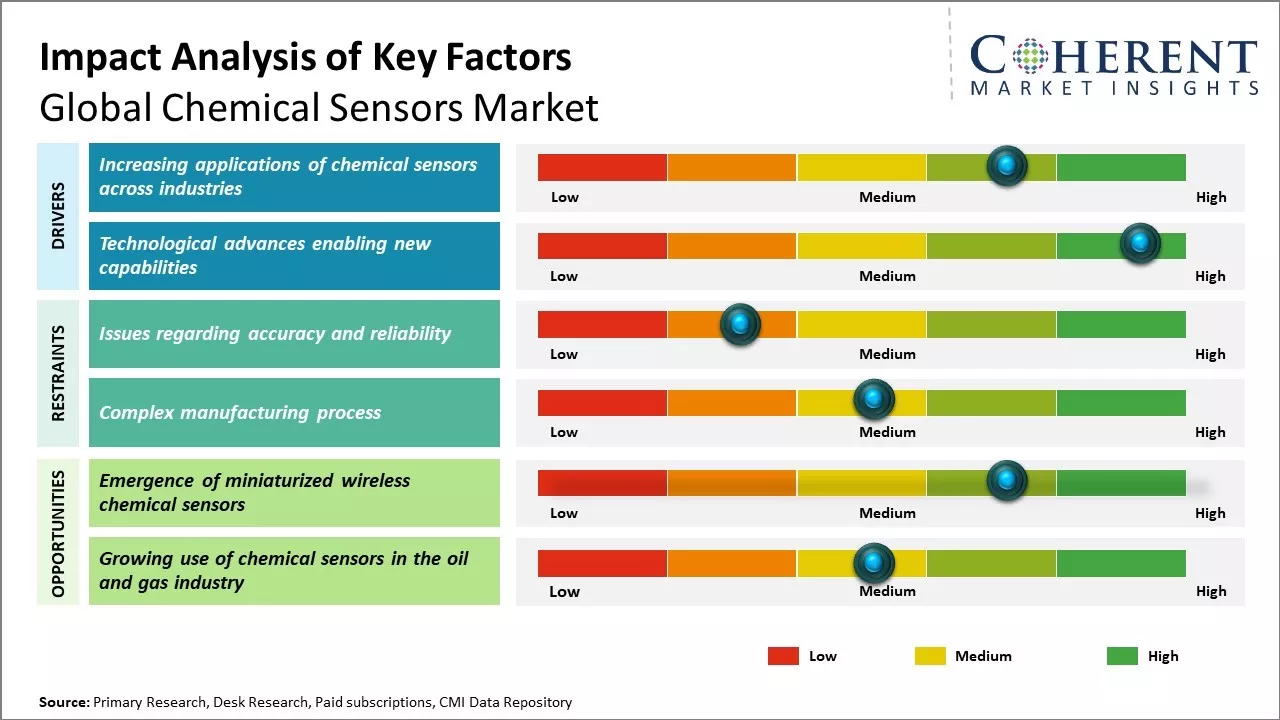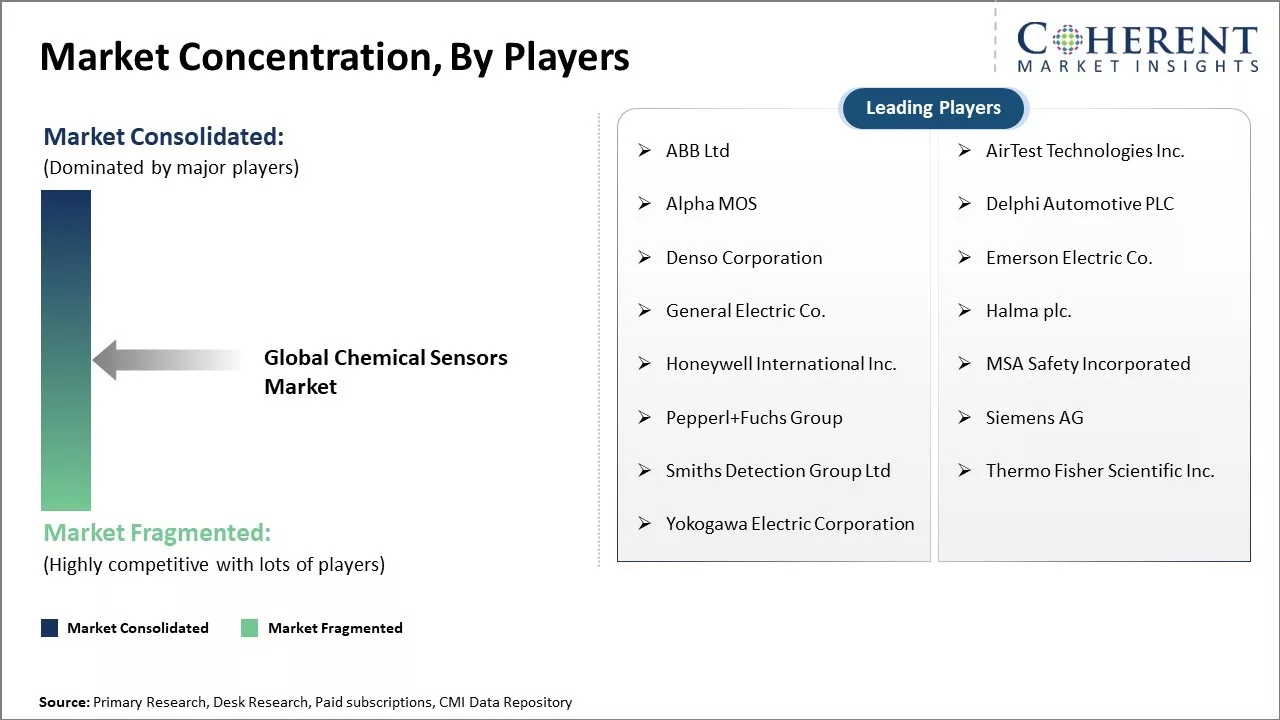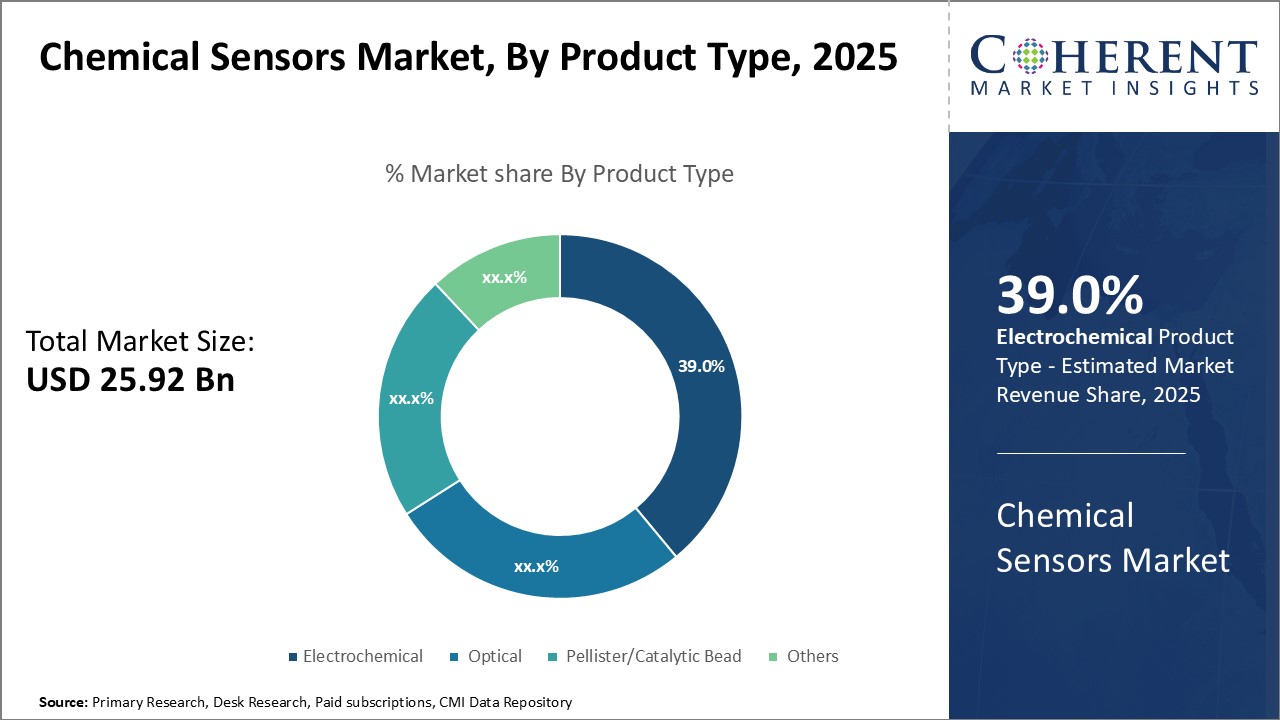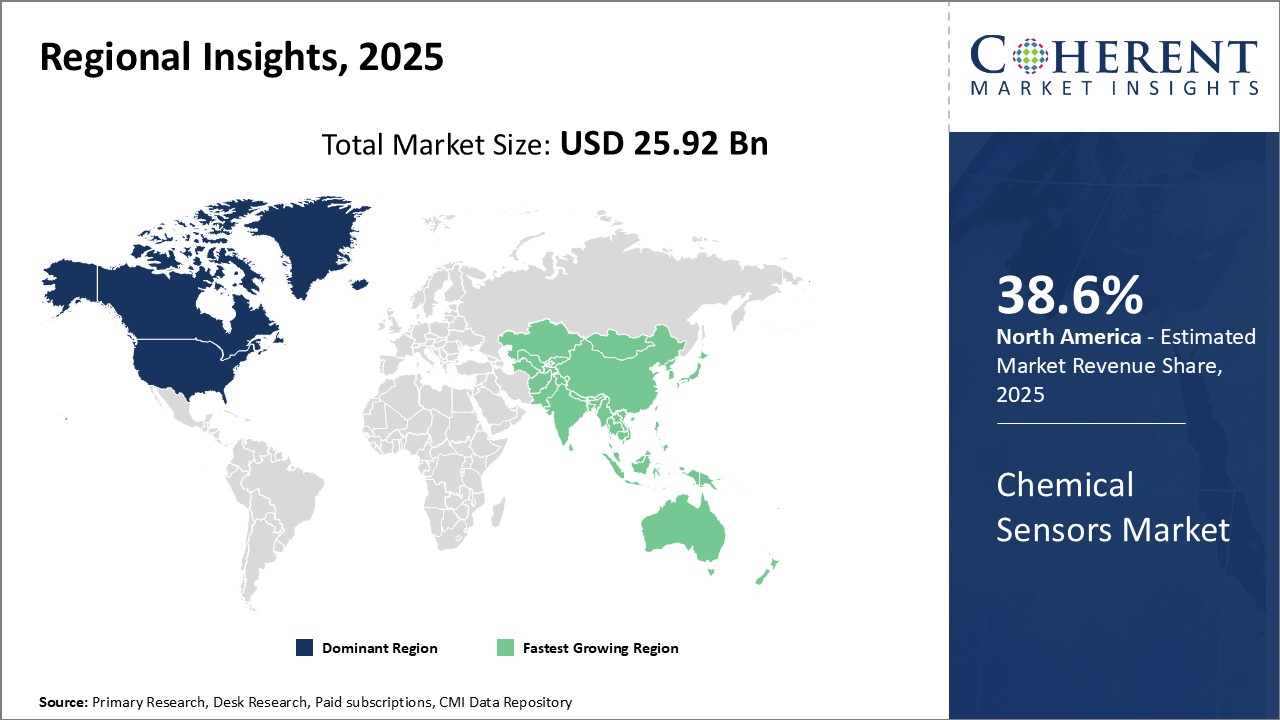Global chemical sensors market is estimated to be valued at US$ 25.92 Bn in 2025 and is expected to reach US$ 42.20 Bn by 2032, exhibiting a compound annual growth rate (CAGR) of 7% from 2025 to 2032.

Discover market dynamics shaping the industry: Request sample copy
Increasing application of chemical sensors in various end-use industries such as industrial, environmental monitoring, medical, and others can drive the market growth. Chemical sensors are used to detect chemical compounds.
The market is expected to witness significant growth during the forecast period due to increasing focus on environment monitoring and health concerns. Furthermore, growing emphasis on safety, quality control, and emerging application areas including home automation can boost demand for chemical sensors. However, high production costs associated with chemical sensors can hamper the market growth over the forecast period.
Increasing applications of chemical sensors across industries
Growing need for real-time detection and monitoring of various chemicals across many industries has significantly boosted demand for chemical sensors. Traditionally, these sensors were used in industries like healthcare, oil & gas and manufacturing for process and quality control but now chemical sensors are used in new domains.
Stringent environmental regulations around the world focusing on air, water and soil pollution monitoring can boost demand for chemical sensors. Various industries whose processes release volatile organic compounds (VOCs) or other harmful emissions in the air are now mandated to continuously track and regulate such emissions. Chemical sensors provide cost-effective, round-the-clock monitoring solutions for industries to adhere to stringent emission standards. Growing wastewater recycling and desalination also boosts need for advanced water quality monitoring systems that uses chemical sensors.
The food processing industry increasingly rely on chemical sensors for ensuring food safety and quality. Right from farming and feed production to packaging, distribution and storage - sensors plays a vital role at various points across the value chain. These help detect contaminants, monitor freshness and check for spoilage. The need for traceability from farm to fork boosts investment in sensor-based quality control solutions.
Even sectors like lifestyle products, consumer durables and automotive are emerging as lucrative application areas. Development of smart homes, appliances and vehicles boosts demand for integration of chemical sensors for functions like pollution detection, leak detection, health monitoring, and others.

Get actionable strategies to beat competition: Request sample copy
Technological advancements enabling new capabilities
Technological advancements help to overcome past limitations of chemical sensors and enable new functionalities. Traditionally, chemical sensors tended to be bulky, required complex sample preparation and could only detect a limited number of analytes. However, ongoing innovation is delivering miniaturized, low-cost, easy-to-use sensing platforms with ultra-high sensitivities.
New nanomaterials like graphene, carbon nanotubes and molybdenum disulfide are empowering designers to build next-generation sensors with enhanced selectivity, speed and stability. Advances in microfabrication allow producing array-based sensors that can simultaneously identify multiple gases and vapors.
Key Takeaways from Analyst:
Increasing safety regulations across major industries such as oil and gas, food and beverage, and healthcare can boost demand for accurate chemical detection and analysis. Strict monitoring of air and water pollution levels can also boost demand for advanced chemical sensors. Increasing application of chemical sensors in agriculture for soil analysis can also offer growth opportunities,
High costs associated with chemical sensor technology research and development can hamper the market growth. Complexity issues in certain sensor designs can challenge wider adoption rates of these sensors. However, ongoing nanotechnology advances can overcome such challenges and make sensors more affordable and user-friendly.
Asia Pacific region, especially China, is predicted to witness the fastest growth and emerge as the largest chemical sensors market due to rapid industrialization and infrastructural investment in the region. North America dominates the market due to strong government funding directed towards developing new age sensory techniques. Europe is also anticipated to offer promising opportunities due to rising environmental monitoring activities.
Market Challenges: Issues regarding accuracy and reliability
Issues regarding accuracy and reliability of chemical sensors can hamper the global chemical sensors market growth. Chemical sensors are used across various industries like healthcare, food technology, agriculture, homeland security, and others for detection of chemicals, gases and other compounds. However, the accuracy and reliability of these sensors is still a concern for end users.
The accuracy of detection is not consistent and depends on various external factors like temperature, humidity and presence of other interfering chemicals in the environment. Even a small variation in accuracy can cause major issues. For example, in healthcare if a gas sensor installed in ICU to detect oxygen level shows even 1-2% lower reading than actual, it can put patient's life at risk. In agriculture, low accuracy pesticide or fertilizer detection sensors can affect crop yields. Inconsistent reliability can also pose challenge as sensors may stop working after few months of usage though designed for years of functioning. This results in additional costs of frequent replacements.
Market Opportunities:
The emergence of miniaturized wireless chemical sensors can provide a great opportunity for global chemical sensors market growth. These miniaturized sensors are revolutionizing the chemical sensing industry by enabling remote and real-time chemical detection and monitoring capabilities. With the advancements in microelectronics and nanotechnology, chemical sensors are becoming smaller in size while also becoming more accurate and cost-effective. This allows for easy deployment of sensor networks across various application areas without significant infrastructure investments.
Some key applications that boosts demand for miniaturized wireless chemical sensors include environmental monitoring, homeland security, healthcare diagnostics, food quality testing and industrial process control. For instance, according to the data from the United Nations Environment Programme, wireless sensor networks deployed across watersheds and coastal regions help dozens of countries to systematically monitor water quality and detect pollution sources faster and more cost-effectively. This allows for timely remedial actions and tracking of policy initiatives.
The current trend of wireless connectivity, IoT and cloud computing can boost demand for miniaturized wireless chemical sensors across diverse application areas globally. Major sensor manufacturers and technology companies are heavily investing in developing advanced chemical sensing platforms comprising of miniature sensors, low-power wireless chips, AI/ML capabilities for advanced data analytics. This will not only enable a wide variety of new use cases but will offer opportunities for leveraging global sensor networks for large-scale real-time monitoring initiatives.

Discover high revenue pocket segments and roadmap to it: Request sample copy
In terms of Product Type, Optical segment contributes the highest share of the market, owing to growing demand from process industries
Optical segment is estimated to contribute the highest market share of 39.0% in 2025, owing to their increasing adoption across various end-use industries such as healthcare, oil and gas, food and beverages. Optical sensors offer several advantages over traditional electrochemical sensors such as high sensitivity, fast response time, longer lifespan and ability to detect a wide range of analytes without being affected by electromagnetic interference and pH levels.
The oil and gas industry is a major consumer of optical sensors for real-time monitoring of various process parameters. Optical sensors play a critical role in leak detection, combustion monitoring, emission monitoring and quality control of petrochemical products. Strict emission norms globally have boosted demand for optical sensors from refineries and petrochemical plants for continuous emissions monitoring.
In healthcare industry, optical sensors are extensively used for diagnostic testing and monitoring of glucose levels, blood oxygen, urine analysis and DNA/RNA assays. Their non-invasive nature and high accuracy boosts their popularity over traditional electrochemical sensors. Growing incidence of chronic diseases also boost demand for home-based monitoring devices equipped with optical sensors.
Food processing industry also relies heavily on optical sensors to analyze parameters such as pH levels, dissolved oxygen and sugar content during various production stages. Their ability to analyze liquid, gaseous and solid samples without any sample preparation makes them ideal for real-time quality control in food manufacturing.
Stringent safety and quality standards across industries boosts demand for optical chemical sensors as these offer reliable, contamination-free monitoring for critical applications. Advancements in nanophotonics and fiber optic technologies has expanded the capabilities of optical sensors.
In terms of By End User, Healthcare segment contributes the highest share of the market due to increasing demand for patient monitoring devices
Healthcare segment is estimated to contribute the highest market share of 42.1% due to rising demand for patient monitoring devices, in vitro diagnostic kits and analytical instruments. Growth in elderly population suffering from chronic medical conditions like diabetes, cardiovascular diseases and respiratory disorders has boosted need for frequent health monitoring. boosts demand for portable, easy-to-use sensors within the patient monitoring segment.
Continuous innovation in biosensors and nanotechnology has led to development of sensors embedded in diagnostic strips, patches and wearable devices for real-time health tracking. Sensors for glucose monitoring have widespread acceptance among diabetics people. Growing incidence of diabetes globally can boost demand for glucose sensing technology. Other types of biosensors are used for monitoring blood oxygen saturation, toxic vapors, infectious bacteria and viruses.
Stringent regulations and guidelines regarding product quality, sterility and packaging of IVD kits have reinforced the need for quality control sensors within diagnostic device manufacturing. Technological advancements have enabled multianalyte detection on a single platform for testing infectious diseases, cardiac markers and tumor biomarkers. This can boost demand for relevant chemical sensors.

Need a Different Region or Segment? Customize now
North America dominates the global chemical sensors globally with an estimated market share of 38.6% in 2025. With the presence of major companies like Honeywell, Thermo Fisher Scientific and TE Connectivity, the North American industry landscape has robust R&D capabilities and infrastructure for manufacturing chemical sensors. The region also has stringent government regulations around workplace safety, environmental protection and homeland security that boosts demand for diverse array of chemical sensors for applications ranging from hazardous gas detection to process control. Moreover, North America has witnessed growth in end-use industries like healthcare, food processing, oil & gas and manufacturing over the past decade. This has provided a stable customer base and steady demand pipeline for chemical sensor providers in the region.
Extensive collaboration between sensor manufacturers and technology startups can also drive the regional market growth. Through partnerships and investment deals, innovative sensing technologies are quickly commercialized and adopted across various verticals. The region has a skilled workforce and culture of entrepreneurship that fosters new product development. Majority of the latest generation gas sensors, liquid sensors and biological sensors have been pioneered in North America. This makes North American chemical sensor brands regarded as global technology leaders.
Asia Pacific region has emerged as the fastest growing market for chemical sensors globally due to manufacturing boom in China and India. Both countries have built massive scale in sectors like automotive, pharmaceuticals, food processing and electronics, which boosts demand for chemical sensors. The governments of China and India are also actively supporting domestic sensor companies through initiatives aimed at import substitution and self-reliance in industrial instrumentation. This propels local R&D and investments in organic growth as well as acquisitions of global players. Asia Pacific region now accounts for nearly a third of the worldwide chemical sensor export business annually led by China. With rising manufacturing capabilities, evolving regulations and high economic growth rates, Asia Pacific is positioned to take the lead in the future.
Chemical Sensors Market Report Coverage
| Report Coverage | Details | ||
|---|---|---|---|
| Base Year: | 2024 | Market Size in 2025: | USD 25.92 Bn |
| Historical Data for: | 2020 To 2024 | Forecast Period: | 2025 To 2032 |
| Forecast Period 2025 to 2032 CAGR: | 7.2% | 2032 Value Projection: | USD 42.20 Bn |
| Geographies covered: |
|
||
| Segments covered: |
|
||
| Companies covered: |
ABB Ltd, AirTest Technologies Inc., Alpha MOS, Delphi Automotive PLC, Denso Corporation, Emerson Electric Co., General Electric Co., Halma plc., Honeywell International Inc., MSA Safety Incorporated, Pepperl+Fuchs Group, Siemens AG, Smiths Detection Group Ltd, Thermo Fisher Scientific Inc., Yokogawa Electric Corporation |
||
| Growth Drivers: |
|
||
| Restraints & Challenges: |
|
||
Uncover macros and micros vetted on 75+ parameters: Get instant access to report
*Definition: Global Chemical Sensors Market refers to the market for various types of chemical sensors that are used for detection and measurement of chemical compounds in multiple industries. Chemical sensors help detect the presence, concentration and quantities of gases and vapors like oxygen, carbon dioxide, ammonia, hydrogen sulfide, and others. These are used in various applications like healthcare, environmental monitoring, food and beverage industry, homeland security, industrial process and more. The global chemical sensors market has been growing steadily due to wide adoption of these sensors across different industry verticals.
Share
Share
About Author
As an accomplished Senior Consultant with 7+ years of experience, Pooja Tayade has a proven track record in devising and implementing data and strategy consulting across various industries. She specializes in market research, competitive analysis, primary insights, and market estimation. She excels in strategic advisory, delivering data-driven insights to help clients navigate market complexities, optimize entry strategies, and achieve sustainable growth.
Missing comfort of reading report in your local language? Find your preferred language :
Transform your Strategy with Exclusive Trending Reports :
Frequently Asked Questions
Joining thousands of companies around the world committed to making the Excellent Business Solutions.
View All Our Clients
US Reciprocal Tax Impact Analysis On Chemical Sensors Market
Stay updated on tariff changes with expert insights and timely information